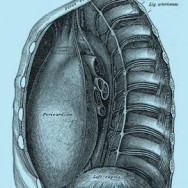
Mediastinal & Thymic Surgery
Background
The mediastinum is a group of structures in the middle of chest. It incudes the heart, the large blood vessels to and from the heart, the oesophagus, the trachea (wind pipe), nerves, the thymus and lymph nodes.
The thymus is a small organ in the upper part of the mediastinum behind the sternum (breast bone). It functions as part of the immune system and is important in making cells that fight infections. Thymomas are malignant tumors that arise in the thymus gland. Although considered malignant, most thymomas grow slowly and tend to spread only locally into surrounding tissues.
Myasthenia gravis is an autoimmune disease where antibodies attack the junction between nerves and muscles, causing progressive weakness. Common symptoms include fatigability, droopy eyelids (ptosis), double vision (diplopia), nasally speech (dysarthria), and a “snaring smile” (weakness of facial muscles). Some patients with myasthenia gravis may have a thymoma, and surgical removal (called thymectomy) can cause the disease to go into remission. Other patients with generalized myasthenia gravis but no thymoma, that cannot be controlled with medications, may also benefit from thymectomy.
About the surgery
Thymectomy can be performed through a number of different approaches:
- Trans-sternal – The sternum (breast bone) is split to access the thymus.
- Trans-cervical – A horizontal incision is made across the lower neck, which is less invasive than the trans-sternal approach.
- Video-assisted thoracic surgery (VATS) or robotic-assisted – Small “keyhole” incisions are used to insert instruments and a camera into the chest, which is the least-invasive approach.
The most important factor is to remove the entire thymus, and possibly some of the surrounding fat too. This ensures the best long-term results are achieved.
Sydney Heart & Lung Surgeons employ VATS or robotic surgery for thymectomy and other operations in the mediastinum when possible. This minimally invasive approach results in better cosmetic results, less pain, shorter hospital stay, and faster recovery. The surgical robot that Sydney Heart & Lung Surgeons use is called the da Vinci Surgical System.
Recovery period
The length of hospital stay will depending on the procedure and the approach used. In general, patients who have a trans-cervical, VATS or robotic thymectomy are usually able to go home 3 to 4 days after surgery. Trans-sternal surgery requires a longer stay, including a short time in intensive care for monitoring.
Risks of the surgery
As with all surgery, there are some risks. In the short-term after the procedure these include wound infection, bleeding, kidney injury, stroke, heart attack, and possibly death. If a minimally invasive approach is attempted but not possible conversion to a more open technique may be required.

